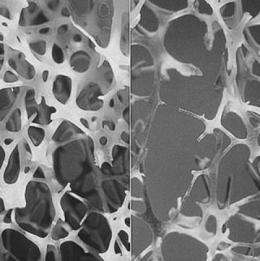Osteoporosis screening: Too common for low-risk women, too uncommon for higher-risk women

Many of those who should get it, don't. And many of those who shouldn't, do. That's the story of a common screening test for osteoporosis, according to new research from UC Davis Health System.
The study, published online today in the Journal of General Internal Medicine, found that screening rates increased sharply among women at age 50, despite guidelines suggesting screening at age 65 unless risk factors are present. The presence of risk factors only had a modest influence on screening decisions.
Osteoporosis causes bone density to diminish and fracture risk to increase. Because gender and age are factors most associated with the disease, the U.S. Preventive Services Task Force recommends screening for women who are age 65 and older. Younger women with certain risk factors—such as a small body frame, a history of fractures or taking medication that thins the bones—should also be screened.
As part of a UC Davis research fellowship, physician Anna Lee Amarnath assessed the electronic health records of nearly 51,000 women who were between the ages of 40 and 85 and received health care in the Sacramento region. Her evaluation included osteoporosis risk factors and whether or not the women received a screening technique called dual-energy X-ray absorptiometry (DXA), which measures bone mineral density.
Over a seven-year period, more than 42 percent of eligible women between the ages of 65 and 74 years were not screened, nor were nearly 57 percent of those older than 75, despite the favorable cost-effectiveness of screening in these age groups. In turn, nearly 46 percent of low-risk women between the ages of 50 and 59 were screened, as were 59 percent of those aged 60 to 64 years without risk factors.
"DXA screening was underused in women at increased fracture risk, including women aged 65 years and older. Meanwhile, it was common among women at low fracture risk, such as younger women without osteoporosis risk factors," Amarnath said, in summarizing the findings.
Amarnath and the study team believe they have identified a common problem, since health care providers can be uncertain or doubtful about current screening recommendations. Doctors tend to think about age-related bone loss when women enter menopause around age 50, triggering consideration of DXA without also considering overall facture risk.
Technology-based solutions could help, according to study senior author Joshua Fenton.
"Health systems should invest in developing electronic health records systems that prompt providers at the point-of-care when screening is needed and when it can be postponed," said Fenton, a UC Davis associate professor of family and community medicine.
More information: A copy of "Underuse and Overuse of Osteoporosis Screening in a Regional Health System: a Retrospective Cohort Study" is available at link.springer.com/article/10.1 … 07/s11606-015-3349-8















